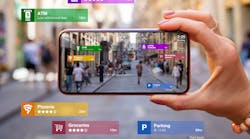This article appears in the CES Show Report in the February 2022 issue of Security Business magazine. When sharing, don’t forget to mention Security Business magazine on LinkedIn and @SecBusinessMag on Twitter.
Augmented Reality, as we reported in an article last month, is poised to be a game-changer for video surveillance applications (read more at www.securityinfowatch.com/21250860). That said, Augmented Reality (AR) has the potential to expand far beyond the surveillance realm, and one company at CES illustrated how AR could be taken even further to dramatically increase the efficiency of field technicians.
ThirdEye is a company that initially debuted back at CES 2018 with its first-generation AR-augmented “smart glasses.” Over the past four years, the company has continued to innovate, creating several iterations of “Mixed Reality” (MR) glasses that “bring about a new era of hands-free human interaction via directly interacting with surrounding objects or placing digital info into [a user’s] field of view.
At CES 2022, ThirdEye took it yet another step further, unveiling Razor, a foldable and much more lightweight version (3 ounces vs. 9.8 ounces) of the MR glasses. While Razor is designed to appeal to consumers in a mixed reality environment, ThirdEye’s X2 MR glasses are targeted at both consumer and the commercial and industrial markets.
“We introduced our X2 glasses a couple of years ago for enterprise and commercial; Razor is a more lightweight version for all-day wear that can connect to an iPhone or Android phone,” explains Nick Cherukuri, ThirdEye’s CEO and Founder. “[Razor] is more for consumer applications, but it can be utilized for enterprise applications too, and we are working extensively in the field technician space – that is actually one of our main use-cases.”
The Field Technician of the Future
Along with the MR glasses, the company’s RemoteEye software enables someone in a back office or support center to remotely see what the technician is seeing in real-time and offer assistance.
“Unlike just live video streaming, this has the additional capability of augmented reality overlays,” Cherukuri explains. “For example, when looking at a machine or different type of equipment, [a field technician] can actually see digital annotation overlays live on the field of view, which is essentially like having an installation manual displayed digitally live in front of you.
“We are excited about this new pair of glasses that will help enable more all-day wear,” Cherukuri adds. “They are much more lightweight on your face, and we continue to see a lot of traction in this remote maintenance and field technician use-case.”
In addition to the live video streaming and remote assistance capability, Cherukuri says the software and glasses can facilitate a task workflow.
“Say a certain project needs 50 different tasks to complete – instead of carrying around a manual or looking down at your phone over and over while you need to use your hands to work, now you can be hands-free and get the entire task checklist displayed live in your field of view,” he says. “You can mark each task as completed, and the team [on-site or at the home office] can also see the progress on a task.”
ROI for Companies
“Within a couple months of deploying this technology, companies are seeing return on investment,” Cherukuri says. “On the enterprise side, such as in telehealth or remote assistance, within a couple months or so they are recouping the cost of deployment.”
The benefits of this type of easily worn AR solution are obvious for a security service provider:
Reduced truck rolls: If a junior technician is having trouble learning a Z-Wave device into a panel, for example, there is no need to roll the supervising technician’s vehicle to the location as well, just have them connect to the glasses remotely to offer assistance – whether they are in the home office or on location at another jobsite.
Of course, as every security business owner knows, reduced truck rolls translate into direct savings on vehicle fuel, maintenance, replacement, etc.
Empowered workforce: Live feedback directly from the most respected experts in your company will give your employees the tools and confidence to perform at their highest level, make better decisions, and avoid delays in solving day-to-day challenges.
Customer satisfaction: Residential and commercial customers both appreciate streamlined installations without multiple visits.
The Challenges
With the hurdle of a lightweight unit addressed, Cherukuri says one of the biggest remaining hurdles to widespread adoption of MR glasses is technology acceptance.
“One of the hardest obstacles is simply that this is an entirely new technology,” Cherukuri explains. “Most people are used to using a tablet or phone, not wearing something on their face for a few hours a day. That's why we took ergonomics and user interface really into account. We also try to offer multiple methods of controlling and using the glasses, such as through voice command, via motion control moving their head or gestures, or even just pressing buttons on the glasses themselves.”
Cherukuri adds that lightweight versions of AR glasses like the Razor will put the technology on the path to worldwide adoption.
“That is something that will put us on the pathway to getting into every household nationwide,” he says. “Our enterprise glasses are successful, but they are focused on enterprise use-cases. To get this technology to be used by hundreds of millions of people, it needs to be something very lightweight, cheaper, and easy to use. I think we are on a path there, and the next two or three years will be really massive for the consumer side of this.”
Learn more about ThirdEye’s XR and Razor MR glasses and remote assistance software at www.thirdeyegen.com.
Paul Rothman is Editor-in-Chief of Security Business magazine. Email him your comments and questions at [email protected]. Access the current issue, full archives and apply for a free subscription at www.securitybusinessmag.com.



